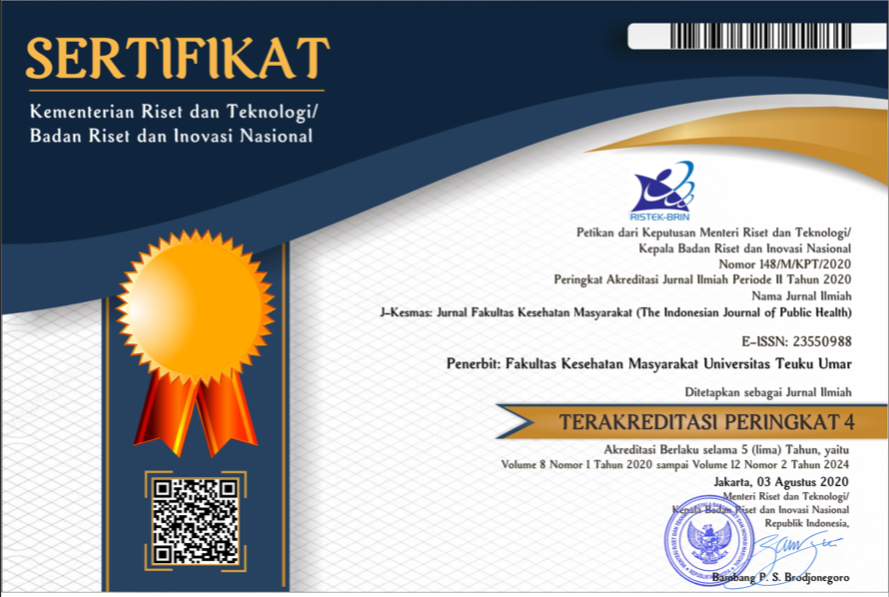Association Consume Sweet Food with Overweight Adolescents
Abstract
Keywords
Full Text:
PDFReferences
Alexandria, VA, (2020). Dietary Patterns and Risk of Cardiovascular Disease: A Systematic Review. Dietary Guidelines Advisory Committee, Dietary Patterns Subcommittee.
Blüher, M. (2019). Obesity: Global Epidemiology and Pathogenesis. Nat Rev Endocrinol. Vol. 15, 288–298. Doi: 10.1038/s41574-019-0176-8.
GBD 2019 Risk Factors Collaborators. (2019). Global Burden of 87 Risk Factors in 204 Countries and Territories, 1990-2019: A Systematic Analysis for The Global Burden of Disease Study 2019. Lancet. 396:1223–49. Doi: 10.1016/S0140-6736(20)30752-2.
Haththotuwa, R.N., Wijeyaratne, C.N., Senarath, U. (2013). Worldwide Epidemic of Obesity. Elsevier: Oxford, UK, Volume 1, pp. 3–11.
Isganaitis, E. & Lustig, R.H. (2005). Fast Food, Central Nervous System Insulin Resistance, and Obesity. Arterioscler Thromb Vasc Biol. Vol. 25 No.12:2451-62. doi: 10.1161/01.ATV.0000186208.06964.91.
Paglia, L. (2019). The Sweet Danger of Added Sugar. Eur J Paediatr Dent. Vol. 20 No. 2: 89. doi: 10.23804/ejpd.2019.20.02.01.
Shetty, Akshatha. (2021). Significance of Sugar Intake Young Adults: A Review. PubMed 2021 Oct 26;33(6):375-378.
Song S., Shim J.E., & Song Y. (2022). Association of added sugar intake with all-cause and cardiovascular disease mortality: a systematic review of cohort studies. Nutrition Research and Practice.16(Suppl1):S21-S36. doi: 10.4162/nrp.2022.16.S1.S21.
Tasevska N, Park Y, Jiao L, Hollenbeck A, Subar AF, Potischman N. (2014). Sugars and Risk of Mortality In The NIH-AARP Diet and Health Study. Am J Clin Nutr 2014;99:1077-88.
Trumbo, P.; Schlicker, S.; Yates, A.A.; Poos, M. Dietary Reference Intakes for Energy, Carbohydrate, Fiber, Fat, Fatty Acids, Cholesterol, Protein and Amino Acids. J. Am. Diet Assoc. 2002, 102, 1621–1630. U.S. Department of Agriculture; U.S. Department of Health and Human Services. Dietary Guidelines for Americans, 2020–2025. 9th Edition. December 2020.
DOI: https://doi.org/10.35308/j-kesmas.v11i1.10110
Refbacks
- There are currently no refbacks.
Managed by Fakultas Kesehatan Masyarakat
Published by Universitas Teuku Umar
Website: http://jurnal.utu.ac.id/jkesmas
Email: jkemas@utu.ac.id 
This work is licensed under a Creative Commons Attribution-ShareAlike 4.0 International License.







.jpg)


